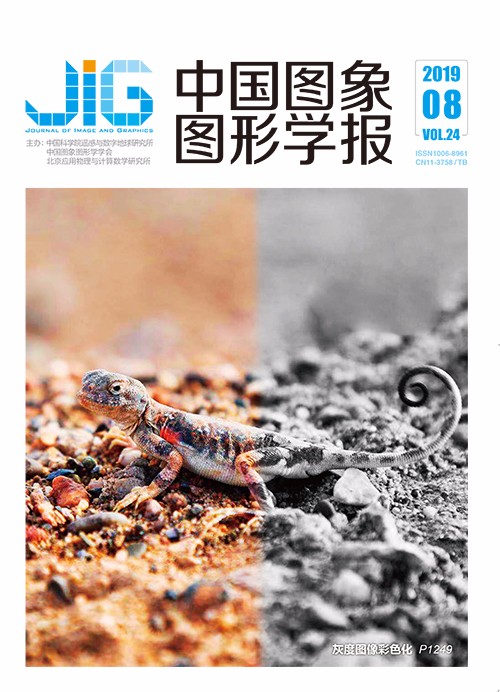
局部自适应的灰度图像彩色化
曹丽琴1, 商永星1, 刘婷婷2, 李治江1, 马爱龙3(1.武汉大学印刷与包装系, 武汉 430079;2.武汉大学中国南极测绘研究中心, 武汉 430079;3.武汉大学测绘遥感信息工程国家重点实验室, 武汉 430079) 摘 要
目的 现有的灰度图像彩色化方法为了保证彩色化结果在颜色空间上的一致性,往往采用全局优化的算法,使得图像边界区域易产生过渡平滑现象。为此提出一种局部自适应的灰度图像彩色化方法,在迁移过程中考虑局部邻域像素信息,同时自动调节邻域像素权重,在颜色正确迁移的同时保证清晰的边界信息。方法 首先结合SVM(support vector machine)和ISLIC(improved simple linear iterative clustering)算法获取彩色图像和灰度图像分类结果图;然后在分类基础上,确定灰度图像高置信度像素点,并根据图像纹理特征,在彩色图像中寻找灰度图像的像素匹配点;最后利用自适应权重均值滤波实现高置信度匹配像素点的颜色迁移,并利用迁移结果对低置信度像素点进行颜色扩散,以完成灰度图像彩色化。结果 实验结果显示,本文方法获得的彩色化迁移结果评分均高于3.5分,特别是局部放大区域评价结果均接近或高于4.0分,高于其他现有彩色化方法评价分数。表明本文方法不仅能够保证颜色迁移的准确性和颜色空间的一致性,同时也能获取颜色区分度高的边界细节信息。与现有的典型灰度图像彩色化方法相比,彩色化结果图在颜色迁移的正确性和抑制边界区域颜色的过渡平滑上都有更优的表现。结论 本文算法为灰度图像彩色化过程中抑制颜色越界问题提供了新的指导方法,能有效地应用于遥感、黑白图像/视频处理、医学图像着色等领域。
关键词
Novelimage colorization of a local adaptive weighted average filter
Cao Liqin1, Shang Yongxing1, Liu Tingting2, Li Zhijiang1, Ma Ailong3(1.School of Printing and Packaging, Wuhan University, Wuhan 430079, China;2.Chinese Antarctic Center of Surveying and Mapping, Wuhan University, Wuhan 430079, China;3.State Key Laboratory of Information Engineering in Surveying, Mapping and Remote Sensing, Wuhan University, Wuhan 430079, China) Abstract
Objective Image colorization is the process of assigning color information to grayscale images and retains grayscale image texture information. The aim of colorization is to increase the visual appeal of an image. This technology is widely used in many areas, such as medical image illustrations, remote sensing images, and old black-and-white photos. Colorization methods have to main categories, namely, user-assisted and automatic colorization methods. User-assisted colorization methods require users to manually define a layer mask or mark color scribbles on a grayscale image. This method is time-consuming and cannot provide sufficient and desirable color scribbles. Automatic colorization methods can reduce user effort and transfer color from a sample color image. The color image is called the reference/source image, and the grayscale image to be colorized is called the target image. The primary difficulty of these automatic colorization methods is to accurately transfer colors and satisfy spatial consistency. Most of these approaches achieve spatial coherency by using weighted filter or global optimization algorithms during colorizing. However, these methods may result in oversmoothed colorization or blur color in edge regions. Method We use a grayscale image colorization approach based on a local adaptive weighted average filter. This proposed method considers local neighborhood pixel information and automatically adjusts the domain pixel weights to ensure correct color migration and clear boundary results. A reference image with similar contents as the target image is provided to achieve color transfer. The method includes the following steps:First, the class probability distribution and classification are obtained. Support vector machine (SVM) is adopted to calculate class probability based on feature descriptors, mean luminance, entropy, variance, and local binary pattern (LBP) and Gabor features. The probability results and classification are post-processed to enhance the spatial coherency combined with superpixels that are extracted based on improved simple linear iterative clustering (ISLIC). Second, the color candidate in the reference image is determined based on matching low-level features in the corresponding class. Thereafter, each pixel with high-confidence class probability is assigned a color from the candidate pixel by using an adaptive weight filter. The adaptive weight, which is defined by the class probability of small neighborhood pixels around the corresponding pixel, can improve local spatial consistency and avoid confusion colorization in the boundary region. Finally, the optimization-based colorization algorithm is used on the remaining unassigned pixels with low-confidence class probability. Result This paper analyzes single pixel-based, weighted average, and adaptive weighted average methods. Results demonstrate that the adaptive weighted average method is better than the other strategies. The colorized images illustrate that our method takes advantage of the other strategies and that it not only has high spatial consistence but also ensures the boundary detail information with high color discrimination. Compared with previous colorization methods, our method works well in colorization. Colorized images achieved by Gupta's method and Irony's method have obvious erroneous colors due to inaccurate matching or corresponding pixels. Charpiat's method produce oversmoothed color on the boundary regions. Images colorized by using Zhang's method are extracted by training more than a million color images and diversities of colors based on CNN. However, some unreliable and undistinguished colors appear on the boundary contours. The colorization results obtained by using a local adaptive weighted average filter ensures the correctness of color transfer and spatial consistence and avoids oversmoothing simultaneously in the edge areas. Thus, our proposed method performs better than the existing methods. The evaluation scores for experimental images using our method are higher than 3.5, especially in local areas, and the evaluation results are close to or higher than 4.0, which is greater than the results of those using the existing colorization method. Conclusion A new colorization approach using color reference images is presented in this paper. The proposed method combines SVM and ISLIC to determine the class probabilities and classifications with high spatial coherence for images. The corresponding pixels are matched based on the space features according to the same class label between the reference and the target images. A local adaptive weighted average filter is defined to transfer the chrominance from the source image to the grayscale image with high-confidence pixels to facilitate spatially coherent colorization and avoid oversmoothing. The colorized pixels are considered automatic scribbles to be spread across all pixels by using global optimization to obtain the final colorization result. Experimental results demonstrate that our proposed method can achieve satisfactory results and is competitive with the existing methods. However, several limitations are observed. First, this method is not fully automated, requiring some human intervention to provide class samples during the process of calculating class probability. Second, the selected space features are not optimal for all images, especially for images with complex textures and rich colors. We will focus on fully automatic operation and general features in our future work.
Keywords
|



 中国图象图形学报 │ 京ICP备05080539号-4 │ 本系统由
中国图象图形学报 │ 京ICP备05080539号-4 │ 本系统由